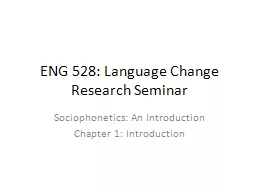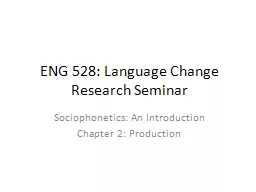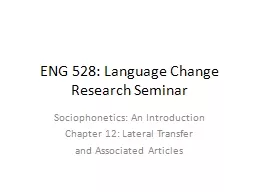PPT-ENG 528: Language Change Research Seminar
Author : tatiana-dople | Published Date : 2018-12-17
Sociophonetics An Introduction Chapter 6 Prosody Sections 6465 Preliminaries of Intonation Boundaries or Juncture delimit different kinds of phrases or individual
Presentation Embed Code
Download Presentation
Download Presentation The PPT/PDF document "ENG 528: Language Change Research Semina..." is the property of its rightful owner. Permission is granted to download and print the materials on this website for personal, non-commercial use only, and to display it on your personal computer provided you do not modify the materials and that you retain all copyright notices contained in the materials. By downloading content from our website, you accept the terms of this agreement.
ENG 528: Language Change Research Seminar: Transcript
Sociophonetics An Introduction Chapter 6 Prosody Sections 6465 Preliminaries of Intonation Boundaries or Juncture delimit different kinds of phrases or individual words Edge Tones mark higherlevel boundaries. Sociophonetics. : An Introduction. Chapter 5: Vowels. Duration. Several uses in speech:. phonological contrasts in quantity (i.e., long vs. short vowels, tense vs. lax vowels, single vs. geminate consonants). Sociophonetics. : An Introduction. Chapter 7: Voice Quality. Lab Exercise # 4. I’ll put 14 . soundfiles. and accompanying . textgrids. on . Moodle. You fill in all the points and labels that go in the tone tier and the break index tier. . Projects. October 30, 2014. . Overview. Project Descriptions. Types of Projects and the Requirements. Faculty Supervised Project. Mitacs. Internship Project. Industrial Internship Project. Project Description. Sociophonetics. : An Introduction. Chapter 1: Introduction. The International Phonetic Alphabet. This is the latest version of the International Phonetic Alphabet (IPA). It was developed beginning in 1886 as a way of representing the sounds of any language. It’s been used ever since for auditory (impressionistic) transcription. Dialectologists and sociolinguists have relied heavily on it.. Sociophonetics. : An Introduction. Chapter 2: Production. Acoustic Concepts. 3 dimensions of sound: . frequency. amplitude. t. ime . phase might be considered a fourth dimension. Frequency. Frequency is the time it takes the wave to go through its pattern; measured in cycles per second (cps), or Hertz (Hz). B. EACH . L. INE . E. XPRESSWAY . E. VACUATION . P. LAN. BLEEP. BLEEP - LIMITS. BLEEP – SR 528 AND SR 417 INTERCHANGE (WEST AND SOUTH WEST SIDE) . SR 528 EB. SR 528 WB. SR 417 NB. SR 417 SB. FHP. FHP. Sociophonetics. : An Introduction. Chapter 12: Lateral Transfer. and Associated Articles. Don’t Forget!. Fill out the class evaluation. https://classeval.ncsu.edu. Let’s see if we can do better than the spring 2010 class, for which only two out of thirteen students filled out the form. ONE GREAT TEACHER; MANY GREAT DESTINIES. ). INTRODUCTION. Recently, the board of proprietors and school management of Ambassadors College . Ile. . Ife. organised the 2015 edition of its Five-Day Annual Staff Seminar, a seminar which was well attended by its teaching and non-teaching staff. Here are feedbacks from some members of staff:. : Copy words and definitions. Word(s) & (PofS) . Definitions. superfluous (adj). not essential. intramural (adj). confined to members (of a school, college, etc.). append (v). attach; “hang on”. ENG IV: Voc. #10 Eng. IV Voc. #10 Day 1 : Copy words and definitions Word(s) & (PoS) Definitions proponent (n) an advocator, supporter haughty (adj) arrogant and condescending deleterious (adj) SIMBOL DAN STRUKTUR DIODA. Menurut. . bahan. . semikonduktor. . ada. 2 . jenis. . dioda. . Dioda. . Silikon. Dioda. Germanium. 2. by IMAM SYAFII, M.Eng. Dioda dengan bias Maju. Dioda dengan bias Negatif. kindly visit us at www.examsdump.com. Prepare your certification exams with real time Certification Questions & Answers verified by experienced professionals! We make your certification journey easier as we provide you learning materials to help you to pass your exams from the first try. Professionally researched by Certified Trainers,our preparation materials contribute to industryshighest-99.6% pass rate among our customers. At Killtest, you can get the essential NS0-528 study materials, which will help you prepare effectively for your NetApp Implementation Engineer Data Protection Specialist (NCIE-DPS) certification exam. Everyone preparing for the NetApp NS0-528 exam should be acquainted with using the NetApp NS0-528 study materials with accurate exam questions. The essential NS0-528 study materials of Killtest will demonstrate your understanding of the NS0-528 exam questions and answers will improve the reliability and trustworthiness of your resume during the occupation industry. #NS0-528 #NS0-528 study materials #NetApp Implementation Engineer Data Protection Specialist (NCIE-DPS) Start Here--- https://tinyurl.com/4bewbuwv ---Get complete detail on NS0-528 exam guide to crack NetApp Certified Implementation Engineer - Data Protection Specialist. You can collect all information on NS0-528 tutorial, practice test, books, study material, exam questions, and syllabus. Firm your knowledge on NetApp Certified Implementation Engineer - Data Protection Specialist and get ready to crack NS0-528 certification. Explore all information on NS0-528 exam with number of questions, passing percentage and time duration to complete test.
Download Document
Here is the link to download the presentation.
"ENG 528: Language Change Research Seminar"The content belongs to its owner. You may download and print it for personal use, without modification, and keep all copyright notices. By downloading, you agree to these terms.
Related Documents














